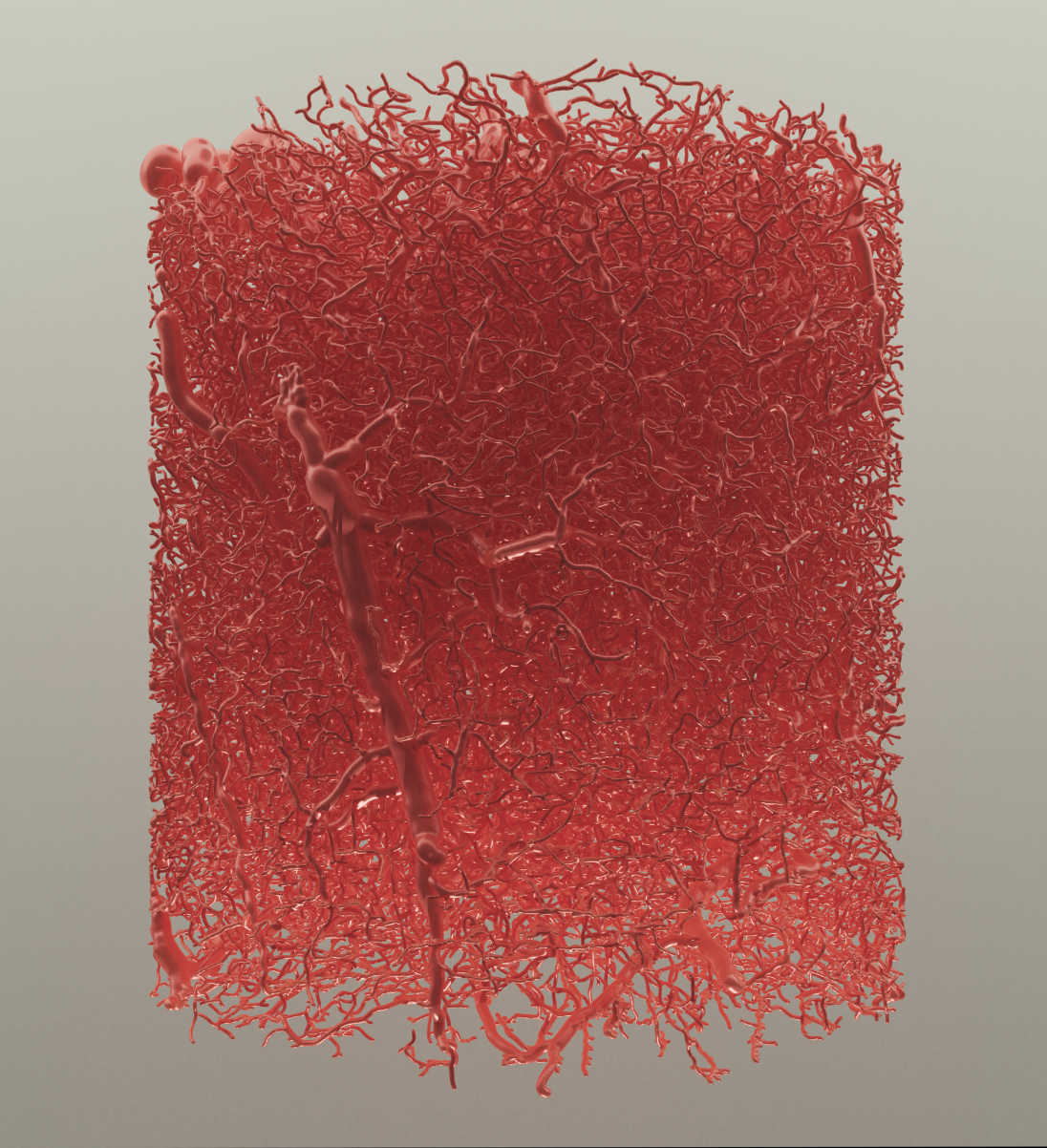VessMorphoVis is an integrated suite of toolboxes for interactive visualization and analysis of vast brain vascular networks represented by morphological graphs segmented originally from imaging or microscopy stacks. Our workflow leverages the outstanding potentials of Blender, aiming to establish an integrated, extensible and domain-specific framework capable of interactive visualization, analysis, repair, high-fidelity meshing and high-quality rendering of vascular morphologies. VessMorphoVis is developed as an extension to its sister NeuroMorphoVis.
-
Interactive visualization, analysis and automated repair of large-scale vasculature morphology skeletons (up to millions of samples).
-
Sketching and building three-dimensional representations of the vascular morphology skeletons using various methods for visual analytics.
-
Analysis of neuronal morphology skeletons that are digitally reconstructed from imaging or microscopy stacks.
-
An easy context to load broken morphology skeletons and repair them manually.
-
Automated reconstruction of polygonal mesh models that represent the surface of the vasvular morphologies based on the piecewise meshing method presented by Abdellah et al., 2017.
-
Accurate mesh reconstruction with MetaBalls to create watertight meshes for reaction-diffusion simulations.
-
Large scale and efficient rendering of the vascular morphologies and meshes using the Workbench renderer.
-
Automated high quality rendering of the vascular morphologies and their corresponding meshes using different shading nodes with Cycles.
-
Exporting the reconstructed meshes in several file formats including PLY, OBJ, STL and also as a Blender file (.blend).
VessMorphoVis is mainly based on Blender. Blender is a free software and can be downloaded from Blender.org. Blender is released under the GNU General Public License (GPL, or “free software”). The current version of VessMorphoVis is compatible with the following Blender versions:
VessMorphoVis can be downloaded as a binary archive bundled within Blender that can be easily extracted and used out-of-the-box. The optional dependencies are already shiped within this archive using pip on each respective platform. This package (released every minor version update of the software) is recommended for Windows users or those who cannot use the Terminal. Otherwise, users can just download an installation script that will automatically install the entire package to a user-specified directory. This script does not require sudo permissions.
The documentation is available here.
Please refer to the github issue tracker for fixed and open bugs. User can also report any bugs and request new features needed for their research. We are happy to provide direct support .
If you use VessMorphoVis for your research, media design or other purposes, please cite our paper Interactive visualization and analysis of morphological skeletons of brain vasculature networks with VessMorphoVis using the following entry:
@article{abdellah2020interactive,
title={Interactive visualization and analysis of morphological skeletons of brain vasculature
networks with VessMorphoVis},
author={Abdellah, Marwan and Guerrero, Nadir Román abd Lapere, Samule and Coggan, Jay S. and
Coste, Benoit and Dagar, Snigdha and Keller, Daniel and Courcol, Jean-Denis and
Markram, Henry and Sch{\"u}rmann, Felix},
journal={Bioinformatics},
volume={In press},
year={2020},
publisher={Oxford University Press}
}
VessMorphoVis is developed by the Visualization team at the Blue Brain Project, Ecole Polytechnique Federale de Lausanne (EPFL). This study was supported by funding to the Blue Brain Project, a research center of the École polytechnique fédérale de Lausanne (EPFL), from the Swiss government’s ETH Board of the Swiss Federal Institutes of Technology.
VessMorphoVis is available to download and use under the GNU General Public License (GPL, or “free software”). The code is open sourced with approval from the open sourcing committee and principal coordinators of the Blue Brain Project in June 2020.
Copyright (c) 2019-2022 Blue Brain Project/EPFL
-
Blender (C) is copyright to Blender Foundation. The Blender Foundation is a non-profit organization responsible for the development of Blender. Blender is released under the GNU Public License, as Free Software, and therefore can be distributed by anyone freely.
-
The SWC morphology samples are available from the Brain Vasculature (BraVa) database. The Brain Vasculature (BraVa) database contains digital reconstructions of the human brain arterial arborizations from 61 healthy adult subjects along with extracted morphological measurements. The arterial arborizations include the six major trees stemming from the circle of Willis, namely: the left and right Anterior Cerebral Arteries (ACAs), Middle Cerebral Arteries (MCAs), and Posterior Cerebral Arteries (PCAs). Citation: Susan N. Wright, Peter Kochunov, Fernando Mut Maurizio Bergamino, Kerry M. Brown, John C. Mazziotta, Arthur W. Toga, Juan R. Cebral, Giorgio A. Ascoli. Digital reconstruction and morphometric analysis of human brain arterial vasculature from magnetic resonance angiography. NeuroImage, 82, 170-181, (2013).
-
The VMV morphology samples are available with permissions from Pablo Blinder, Department of Neurobiology at the Tel Aviv University, Israel.
-
The H5 morphology samples are available with permissions from the Blue Brain Project, Ecole Polytechnique Federale de Lausanne (EPFL). The original dataset courtesy of Bruno Weber, University of Zurich, Switzerland.
-
VessMorphoVis depends on the MorphIO library to load H5 morphologies. MorphIO is licensed under the terms of the GNU Lesser General Public License version 3.
-
The table of contents for all the user documentation pages are generated with markdown-toc.
For more information on VessMorphoVis, comments or suggestions, please contact:
Marwan Abdellah
Scientific Visualiation Expert
Visualization Team, Computing Division
Blue Brain Project
[email protected]
marwan-abdellah.com










